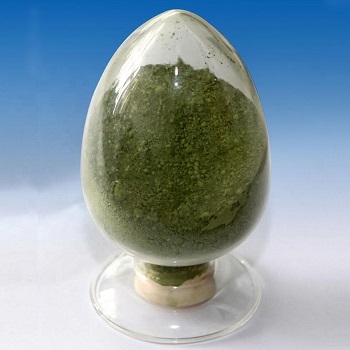Chinhydron Chemische Eigenschaften,Einsatz,Produktion Methoden
R-Sätze Betriebsanweisung:
R22:Gesundheitsschädlich beim Verschlucken.
R36/37/38:Reizt die Augen, die Atmungsorgane und die Haut.
R50:Sehr giftig für Wasserorganismen.
S-Sätze Betriebsanweisung:
S26:Bei Berührung mit den Augen sofort gründlich mit Wasser abspülen und Arzt konsultieren.
S36:DE: Bei der Arbeit geeignete Schutzkleidung tragen.
S61:Freisetzung in die Umwelt vermeiden. Besondere Anweisungen einholen/Sicherheitsdatenblatt zu Rate ziehen.
S37/39:Bei der Arbeit geeignete Schutzhandschuhe und Schutzbrille/Gesichtsschutz tragen.
S29:Nicht in die Kanalisation gelangen lassen.
Chemische Eigenschaften
a dark green crystalline powder which is a complex formed by benzoquinone and hydroquinone.

Quinhydrone is a general reagent used in potentiometric titrations. It can also be used as a π-acceptor in the formation of charge-transfer complex of analytes for spectrophotometric analysis.
Verwenden
In pH determinations (quinhydrone electrode).
Definition
The so-called quinhydrone electrode, containing equivalent amounts of p-benzoquinone and hydroquinone, is used to determine hydrogen ion concentrations of unknown solutions. Hydroquinone is used principally as a photographic developing agent. The main advantages of the quinhydrone electrode are low internal resistance, rapid response, high accuracy, simplicity, free of errors due to the presence of nonreducing gases, and free of salt errors. Major limitations are that it contaminates the solution, cannot be used to monitor a flowing solution, the solution must be free of strong oxidizing and reducing agents, and it is limited to a pH range of 1 to 9. In alkaline solution, the weakly acidic H2Q is neutralized and is subject to oxidation by air and dissolved oxygen. The main application of the quinhydrone electrode is in nonaqueous solvents where reproducible results are obtained in a variety of solvents. The tetra-chloro derivative (chloranil electrode) is even more useful.
Allgemeine Beschreibung
Quinhydrone/methanol treatment for the measurement of carrier lifetime in crystalline silicon substrates has been reported. Surface passivation of silicon substrates by quinhydrone/ethanol treatment has been investigated.
Hazard
Toxic by ingestion.
läuterung methode
Crystallise quinhydrone from H2O at 65o , then dry it in vacuo.[Beilstein 7 H 617, 7 IV 2069.]
Chinhydron Upstream-Materialien And Downstream Produkte
Upstream-Materialien
Downstream Produkte

